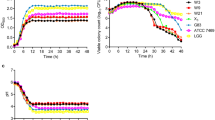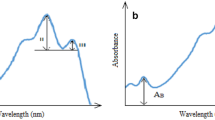Abstract
This study focuses on the development of functional probiotics using caroteonid-producing lactic acid bacteria (LAB) with antioxidant properties. Thirty LAB strains were evaluated for their probiotic properties. Carotenoid biosynthesis gene cluster (crtMN operon) was detected using polymer chain reaction (PCR). The carotenoid identified as 4,4′-diaponeurosporene was analyzed via UV visible absorption spectra and HPLC. Five carotenoid-producing strains showed antioxidant activities. Lactiplantibacillus plantarum MGB0112, which showed the highest carotenoid production measuring at 470 nm of absorbance per ml of culture broth (0.014 A470nm/ml), showed low pH (56.5%) and bile salt (97.8%) tolerance with high adhesion properties (55.1% for toluene). Furthermore, this strain and 4,4′-diaponeurosporene extract exhibited antioxidant activity (99.5 and 40.1%, respectively) against DPPH free radicals in vitro. Their antioxidant properties were confirmed in vivo (45.6 and 55.2% survival rates in Caenorhabditis elegans). Therefore, C30 carotenoid-producing strain MGB0112 demonstrates outstanding antioxidant effects and can be a potential functional probiotics.





Similar content being viewed by others
References
Bauer AW, Kirby MM, Sherris JC, Truck M. Antibiotic susceptibility testing by a standardized single disk method. American Journal of Clinical Pathology. 45: 493-496 (1966)
Cho ES, Chun J, Park J, Kim M, Hwang CY, Yoon DJ, Siziya IN, Seo DH, Seo MJ. In vitro assessment of probiotic properties for lactic acid bacteria isolated from Korean traditional fermented food, kimchi. Current Topics in Lactic Acid Bacteria and Probiotics. 6(1): 17-24 (2020)
CLSI. Performance standards for antimicrobial susceptibility testing; twenty-second informational supplement. Clinical and Laboratory Standards Institute. 32: 44-49 (2012)
Collado MC, Meriluoto J, Salminen S. In vitro analysis of probiotic strain combination to inhibit pathogen adhesion to human intestinal mucus. Food Research International. 40: 629-636 (2007)
Collado MC, Meriluoto J, Salminen S. Adhesion and aggregation properties of probiotic and pathogen strains. European Food Research and Technology. 226: 1065-1073 (2008)
Dowarah R, Verma AK, Agarwal N, Singh P, Singh BR. Selection and characterization of probiotic lactic acid bacteria and its impact on growth, nutrient digestibility, health and antioxidant status in weaned piglets. PLoS ONE. 13: e0192978 (2018)
Feng T, Wang, J. Oxidative stress tolerance and antioxidant capacity of lactic acid bacteria as probiotic: a systematic review. Gut Microbes. 12: e1801944 (2020)
Gao YR, Li DP, Liu XY. Effects of Lactobacillus sakei C2 and sakacin C2 individually or in combination on the growth of Listeria monocytogenes, chemical and odor changes of vacuum-packed sliced cooked ham. Food Control. 47: 27-31 (2015)
Garrido-Fernández J, Maldonado-Barragán A, Caballero-Guerrero B, Hornero-Méndez D, Ruiz-Barba JL. Carotenoid production in Lactobacillus plantarum. International Journal of Food Microbiology. 140(1): 34-39 (2010)
Hagi T, Kobayashi M, Kawamoto S, Shima J, Nomura M. Expression of novel carotenoid biosynthesis genes from Enterococcus gilvus improves the multistress tolerance of Lactococcus lactis. Journal of Applied Microbiology. 114: 1763-1771 (2013a)
Hagi T, Kobayashi M, Kawamoto S, Shima J, Nomura M. Expression of novel carotenoid biosynthesis genes from Enterococcus gilvus improves the multistress tolerance of Lactococcus lactis. Journal of Applied Microbiology. 114: 1763-1771 (2013b)
Hagi T, Kobayashi M, Nomura M. Aerobic condition increases carotenoid production associated with oxidative stress tolerance in Enterococcus gilvus. FEMS Microbiology Letters. 350: 223-230 (2014)
Han Q, Kong B, Chen Q, Sun F, Zhang H. In vitro comparison of probiotic properties of lactic acid bacteria isolated from Harbin dry sausages and selected probiotics. Journal of Functional Foods. 32: 391-400 (2017)
Ikeda T, Yasui C, Hoshino K, Arikawa K, Nishikawa Y. Influence of lactic acid bacteria on longevity of Caenorhabditis elegans and host defense against Salmonella enterica Serovar Enteritidis. Applied and Environmental Microbiology. 73:6404-6409 (2007)
Jang HJ, Lee NK, and Paik HD. Probiotic characterization of Lactobacillus brevis KU15153 showing antimicrobial and antioxidant effect isolated from kimchi. Food Science and Biotechnology. 28: 1521-1528 (2019)
Kanmani P, Kumar RS, Yuvaraj N, Paari KA, Pattukumar V, Arul V. Probiotics and its functionally valuable products—A Review. Critical Reviews in Food Science and Nutrition. 53: 641-658 (2013)
Kim M, Seo DH, Park YS, Cha IT, Seo MJ. Isolation of Lactobacillus plantarum subsp. plantarum producing C30 carotenoid 4,4′-diaponeurosporene and the assessment of its antioxidant activity. Journal of Microbiololgy and Biotechnology. 29: 1925-1930 (2019)
Lee NK, Han KJ, Son SH, Eom SJ, Lee SK, Paik HD. Multifunctional effect of probiotic Lactococcus lactis KC24 isolated from kimchi. LWT-Food Science and Technology. 64: 1036-1041 (2015)
Llopis S, Rodrigo MJ, González N, Genovés S, Zacarías L, Ramón D, Martorell P. β-Cryptoxanthin reduces body fat and increases oxidative stress response in Caenorhabditis elegans model. Nutrients. 11: 232 (2019)
Mishra V, Shah C, Mokashe N, Chavan R, Yadav H, Prajapati J. Probiotics as potential antioxidants: A systematic review. Journal of Agricultural and Food Chemistry. 63: 3615-3626 (2015)
Nair MS, Amalaradjou MA, Venkitanarayanan K. Chapter one-antivirulence properties of probiotics in combating microbial pathogenesis. Advances in Applied Microbiology. 98: 1-29 (2017)
Ram S, Mitra M, Shah F, Tirkey SR, Mishra S. Bacteria as an alternate biofactory for carotenoid production: A review of its applications, opportunities and challenges. Journal of Functional Foods. 67: 103867 (2020)
Rathor L, Pant A, Awasthi H, Mani D, Pandey R. An antidiabetic polyherbal phytomedicine confers stress resistance and extends lifespan in Caenorhabditis elegans. Biogerontology. 18(1): 131-147 (2017)
Reuben RC, Roy PC, Sarkar SL, Alam RU, Jahid IK. Isolation, characterization, and assessment of lactic acid bacteria toward their selection as poultry probiotics. BMC Microbiology. 19: 253 (2019)
Saarela M, Mogensen G, Fonden R, Matto J, Mattila-Sandholm T. Probiotic bacteria: safety, functional and technological properties. Journal of Biotechnology. 84: 197-215 (2000)
Schaffsma G. State of the art concerning probiotic strains in milk products IDF. Nutrition Newsletter. 5: 23-24 (1996)
Sharma P, Tomar SK, Sangwan V, Goswami P, Singh R. Antibiotic Resistance of Lactobacillus sp. Isolated from Commercial Probiotic Preparations. Journal of Food Safety. 36: 38-51 (2015)
Siziya IN, Yoon DJ, Kim M, Seo MJ. Enhanced production of C30 carotenoid 4,4'-diaponeurosporene by optimizing culture conditions of Lactiplantibacillus plantarum subsp. plantarum KCCP11226T. Journal of Microbiology and Biotechnology. 32: 892-901 (2022)
Son SH, Jeon HJ, Jeon EB, Lee NK, Park YS, Kang DK, Paik HD. Potential probiotic Lactobacillus plantarum Ln4 from kimchi: Evaluation of β-galactosidase and antioxidant activities, LWT - Food Science and Technology. 85: 181-186 (2017)
Takaichi S, Inoue K, Akaike M, Kobayashi M, Oh-oka H, and Madigan MT. The major carotenoid in all known species of heliobacteria is the C30 carotenoid 4,4′-diaponeurosporene, not neurosporene. Archives of Microbiology. 168: 277-281 (1997)
Turpin W, Renaud C, Avallone S, Hammoumi A, Guyot JP, Humblot C. PCR of crtNM combined with analytical biochemistry: an efficient way to identify carotenoid producing lactic acid bacteria. Systematic and Applied Microbiology. 39: 115-121 (2016)
Wieland B, Feil C, Gloria-Maercker E, Thumm G, Lechner M, Bravo JM, Poralla K, Götz F. Genetic and biochemical analyses of the biosynthesis of the yellow carotenoid 4,4'-diaponeurosporene of Staphylococcus aureus. Journal of Biotechnology. 176: 7719-7726 (1994)
Acknowledgements
This work was supported by Incheon National University Research Grant in 2021.
Author information
Authors and Affiliations
Corresponding author
Ethics declarations
Conflict of interest
The authors declare that there is no conflict of interest.
Additional information
Publisher's Note
Springer Nature remains neutral with regard to jurisdictional claims in published maps and institutional affiliations.
Rights and permissions
Springer Nature or its licensor (e.g. a society or other partner) holds exclusive rights to this article under a publishing agreement with the author(s) or other rightsholder(s); author self-archiving of the accepted manuscript version of this article is solely governed by the terms of such publishing agreement and applicable law.
About this article
Cite this article
Hwang, C.Y., Cho, ES., Yoon, D.J. et al. Probiotic and antioxidant properties of C30 carotenoid-producing Lactiplantibacillus plantarum isolated from kimchi. Food Sci Biotechnol 32, 543–552 (2023). https://doi.org/10.1007/s10068-022-01226-5
Received:
Revised:
Accepted:
Published:
Issue Date:
DOI: https://doi.org/10.1007/s10068-022-01226-5




